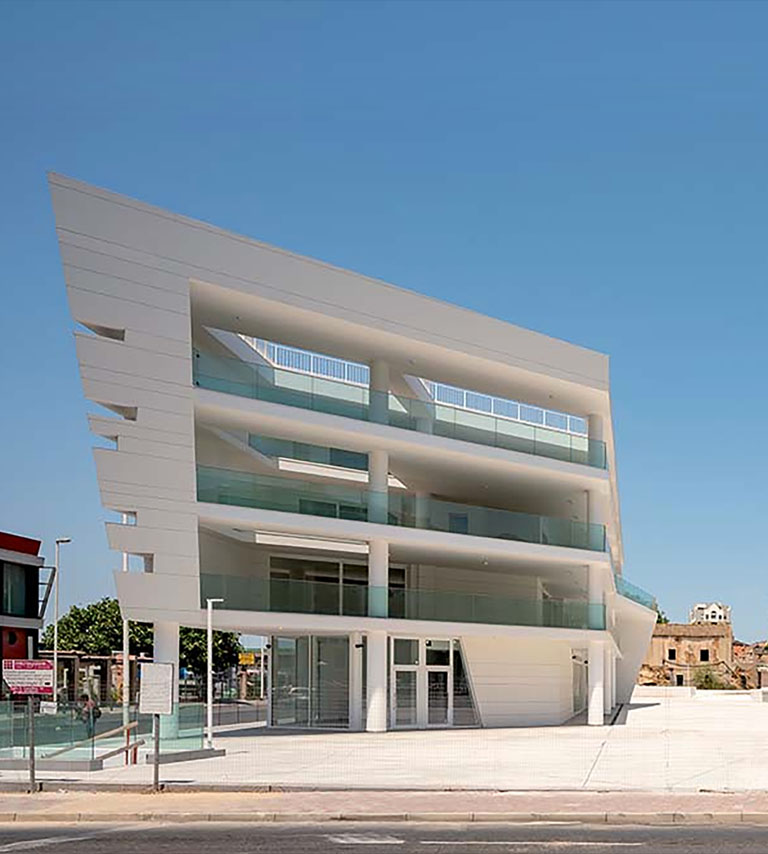

Installing tiles on façades
Requirements, considerations and solutions for applications with high aesthetic value
Requirements, considerations and solutions for applications with high aesthetic value
Installing ceramic tiles on façades can give great results in aesthetic and decorative terms, but designers and installers need to take a series of points and details into consideration in order to obtain results that remain durable and reliable over time from a safety perspective.
Let’s talk about substrates: how should they be prepared prior to installation?
Substrates must be prepared in compliance with current standards. For instance, Italian standard UNI 11493-1 requires the maximum attention and respect for the specified requirements in the case of installations on façades, which is a particular type of application where safety concerns also need to be addressed. When tiles are installed, the substrate must comply with requirements regarding its state and condition as prescribed by the standards, that is:
• curing;
• integrity;
• resistance (strength) of the surface;
• dimensional regularity;
• surface finish;
• moisture content;
• absence of contaminants.
With façades, which means ceramic tiles on external walls (Class R.4, Table 2, notes 7.2.1) characterised by significant vertical development (i.e. taller than 3 m) and, taking into consideration potential safety risks in the case of tiles becoming detached and the particularly high stresses generated by thermal/hygrometric variations, additional precautions and measures are specified, one of the main ones being that the substrate must have a pull-off strength of at least 1 N/mm2. This requirement complies with the specific requirements of cementitious adhesives used for installing ceramic tiles on façades which, since they have to be class C2 adhesives according to EN 12004, must comply with the same parameters.
One of the main factors desigers have to take into consideration is the amount of movement between the substrate and ceramic tiles due to temperature variations. What characteristics must an adhesive have in order to prevent these movements leading to detachment of the tiles? What characteristics must an adhesive have for this type of use?
Apart from the aforementioned conditions and requirements for the substrate, two parameters play a particularly important role: the presence of tile joints and expansion joints and the use of adhesives characterised by a high level of deformability, which is linked to their modulus of elasticity. The aim is to reduce the elastic modulus of the entire ceramic tile system as much as possible so that it is able to absorb the stresses generated when in service as a result of thermal/hygrometric variations, as well as the normal in-service stresses and loads. And to this aim, when using cementitious adhesives (class C according to EN 12004), we recommend prescribing adhesives with class S1 or S2 deformability. The capacity of these adhesives to cushion differential stresses generated between the substrate and the ceramic covering when in service reduces the risk of these stresses causing detachment or failure of the ceramic covering, particularly when associated with an appropriate layout of tile joints and expansion joints that have been correctly sized and sealed.
In general, the double-buttering technique should be prescribed when the compactness of the layer of adhesive and the absence of cavities or gaps under the tiles – that is, to achieve a “full” installation bed – are essential requirements, but which are generally difficult to achieve using the conventional single-buttering method. On façades, with tiles with the longest side measuring more than 30 cm, the double-buttering technique is prescribed to ensure there is a full installation bed. The same measure, however, is also recommended for smaller formats. In the case of tiles where the longest side is more than 30 cm, the designer should also assess whether the use of additional mechanical safety fasteners should be prescribed (such as metal hooks fastened into the substrate), by taking into consideration specific exposure conditions, the state and condition of the substrate and the installation pattern (dimensions of the joints, layout of elastic joints, etc.).
What type of tiles are the most suitable for façades?
Tiles with a high level of solar reflectance, which is the property of a material to reflect solar radiation. Light colours, and white in particular, have high solar reflectance which reduces the build-up of heat, the effect being directly proportional to a reduction in stresses due to the coefficient of linear thermal expansion. The best types of ceramic tiles are those with low absorption and high mechanical characteristics such as porcelain (group BIa, water absorption of between 0 and 0.5%): these tiles are fired at a temperature of between a minimum of 1180 °C and a maximum of 1250 °C, in which the high firing temperature and selected clay give the final product very high resistance and strength and virtually zero water absorption. Their main characteristics include toughness, frost-resistance, resistance to chemical agents and impermeability. Because of their performance, technical and aesthetic characteristics, they are suitable for both internal and external use, and for applications ranging from public buildings to private homes. Smaller tiles may also be used as an alternative: while not offering the same result regarding aesthetics, they guarantee that the ceramic covering is less rigid.
What does Mapei propose for tile and expansion joints?
All Mapei grouts are suitable for joints on façades. ULTRACOLOR PLUS grout is the jewel in the crown of Mapei cementitious grouts: a high performance, ant-efflorescence, rapid-setting and drying, polymer-modified product for grouting 2 to 20 mm wide joints, with water-repellent DropEffect® and mould-resistant BioBlock® technology, class CG2 WA in compliance with EN 13888. It guarantees stability, uniformity of colour and short waiting times before cleaning and finishing. It has excellent resistance to abrasion, freeze/thaw cycles and UV rays and is extremely durable. Also noteworthy is its EMICODE EC1PLUS classification by GEV. Mapei grouts have very low emission of volatile organic compounds (VOC) so are safe for the health of both those who use them and of those who use and live in areas where they have been used.
From all the Mapei adhesives, which is the most suitable for this type of application?
Numerous Mapei adhesives can be used for installing ceramic tiles on façades and should be chosen according to the different installation conditions. KERAFLEX MAXI S1, ULTRALITE S2 and KERABOND+ISOLASTIC are all valid solutions for most applications.
Ceramic tiles were bonded on the façades of the former Zedda Piras factory in Cagliari (Italy) with ULTRALITE S2 adhesive before grouting joints with ULTRACOLOR PLUS.







